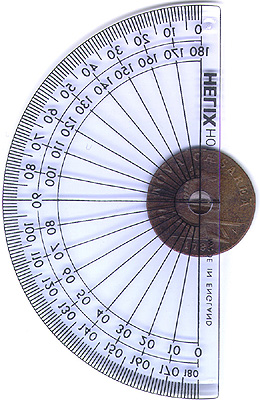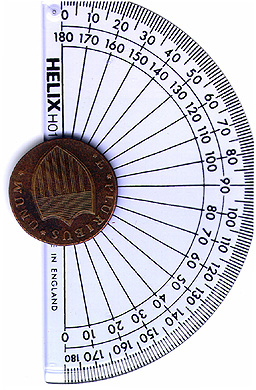For each coin weight, diameter and reverse die rotation measurements are noted. The measurements were done as follows.
Each coin was weighed on a Dillon Precision D-Terminator scale which gave the weight in both grains and grams. Grains were calculated to the tenth of a grain and grams to the one hundredth of a gram. The scale was regularly calibrated and each coin was weighed several times. Only weights that could be be replicated several times were accepted. Anyone who has weighed coins realizes that several factors from atmospheric pressure to precisely where the coin is placed on the tray will affect the result. As the grain weight is the smaller unit of measurement, a coin may vary ± within a tenth of a grain, but this difference may not affect the gram weight. Generally weights should be able to be replicated and certainly should be within ± one tenth of a grain.
The diameter of each coin was measured with dial calipers calibrated to one hundredth of a millimeter. The use of a dial with a needle made reading easy. However, although coin diameter is rather easily measured, it is difficult to replicate because almost no colonial coin in uniformly round. It is possible for individuals to obtain readings that vary as much as a millimeter, or even a bit more, on the same coin. We took several readings and recorded the largest diameter measurement obtained for the coin. Although our instrument measured to the hundredth of a millimeter we generally limited the reading to the nearest tenth of a millimeter. By always using the largest diameter we are be able to replicate our measurements fairly closely and certainly within ± two tenths of a millimeter. Much of the difference will be depend on how level the coin is held in the calipers.
This is a measurement of the degree of difference between the axis of the obverse of the coin and the reverse of the coin. Basically, it reveals the alignment of the dies when they were attached to the press. I have only recently started adding this information as I was awaiting some standardized method of measurement. For the present I have adopted the basic method explained by Roger Moore in the article "On the Measurement of Die Rotations" in The Colonial Newsletter vol. 37, no. 3 (December 1997, serial no. 106) 1761-1764. Namely, I have assumed the obverse faces straight up at 0° on a protractor with a "normal" coin turn orienting the reverse so that the top of the reverse would point to 180° on the protractor.
Below is an example of a measurement (for a NJ Maris 14-J) and an explanation of how it was done. Each example may be clicked to enlarge it. As these measurements were put in a scanner they are somewhat off center. Every time I put the loose coin and proctractor down on the scanner the coin would slip out of position slightly. The images shown below are the the most accurately alligned scans I could get, short of glueing or tapeing the coin to the protractor! I believe they demonstrate the procedure even if it the readings may be slightly off center. The obverse shows the protractor on top of the coin, while the reverse is turned (so the right side is flipped to the left) and shows the coin on top of the protractor as explained below. The reverse die rotation for this Maris 14-J is 170°
obv at 0° (or 360°) rev at 170°
rev at 170°
In each case I have used a clear plastic protractor to orient the obverse. I tried to orient the coin with the 0°/180° proctractor line running through the center of the obverse from top to bottom (dividing the coin into right and left halves) and the 90°/270° line running through the center from side to side (dividing the coin into a top and a bottom half). As there is no standard central orientation point one needs to improvise by creating an imaginary center using features on the coin as a guide. For the top to bottom axis I have used reference points such as the mid portion of the date, the center of the bust or center of a standing figure, to equally divide the right and left sides of the coin. For the side to side line, which divides the top and bottom halves of the coin there are usually no specific reference points, just a general estimation of an equal division. Clearly, this imaginary center line is subjective and naturally will lead to a difference in measurement depending on where the line is drawn!
With the coin held firmly in place I then turn over the clear plastic protractor (flipping the right edge sideways to the left side as explained by Hodder in the article cited above). At this point the reverse orientation can be read. I then draw an imaginary line through the center of the reverse, sometimes using a sheet of paper as a straight edge. Again, as there is no standard orientation, I use the center of the liberty head, the center of the date or other reference points (on NJ coppers the center top point of the shield is helpful). Using the imaginary point at the top center of the reverse I then read the degrees on the protractor from a clockwise direction and record the degree reading as the reverse die rotation. As stated above the example displayed has a 170° reverse die rotation based on the orientation of the center point on the top of the shield. As with the obverse, the measurement will differ somewhat depending on the specific point that is selected as the center. However, even though the center alignment is rather subjective I have discovered this process can be replicated ±5° without much difficulty, as most people are within a few degrees of each other in determining the center. Of course there are some exceptions, for example, the obverse center orientation of the Constellatio Novas may present more problems than most coins (that is one reason I have not done them as yet). Some have explained that one can take readings using a circle drawn on paper with the degrees marked off. I have not used this method as I have never been able to be assured the obverse was precisely oriented to 0° when the reverse was being read!
|
For questions or comments contact Special Collections by: |